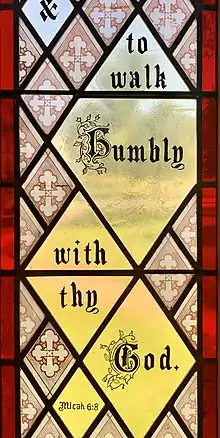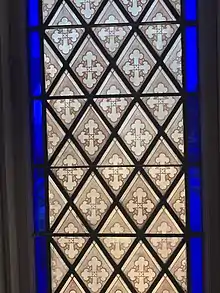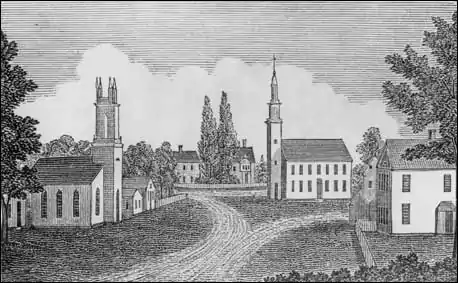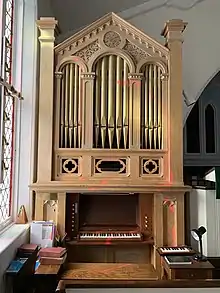| Christ Church | |
|---|---|
 Christ Church Exterior, 2018 | |
 Christ Church Location in Connecticut  Christ Church Location in the United States | |
| 41°38′18″N 73°12′32″W / 41.63829°N 73.20899°W | |
| OS grid reference | JQQR+89 Bethlehem, Connecticut |
| Location | 18 Main St. S., Bethlehem, CT 06751 |
| Country | United States |
| Language(s) | English |
| Denomination | Episcopalian |
| Website | www |
| History | |
| Founded | March 13, 1807 as "Episcopal Society of Bethlem"[1] |
| Consecrated | September 23, 1835 |
| Past bishop(s) | Rt. Rev. Thomas Church Brownell |
| Architecture | |
| Heritage designation | National Historic District building |
| Designated | December 16, 1982 |
| Architect(s) | 1871 renovations by Robert W. Hill, architect[2] |
| Architectural type | Gothic Revival |
| Years built | 1829, 1871, 1932, 1955, 1983 |
| Groundbreaking | 1829 |
| Completed | 1832 |
| Specifications | |
| Length | 44 ft. |
| Width | 30 ft. |
| Number of towers | 1 |
| Materials | brick, wood, pressed metal |
| Bells | 1 by Meneely Bell Foundry |
| Tenor bell weight | 938 lb (425 kg). |
| Administration | |
| Division | Anglican Communion |
| Subdivision | The Episcopal Church |
| Province | I |
| Diocese | The Episcopal Church in Connecticut (since 1785) |
| Episcopal area | Northwest Region |
| Clergy | |
| Bishop(s) | Rt. Rev. Jeff W. Mello, Bishop Diocesan; Rt. Rev. Laura J. Ahrens, Bishop Suffragan |
| Laity | |
| Organist(s) | Stephanie Biello |
| Treasurer | Gregg Douglas |
| Churchwarden(s) | David Maddox |
Christ Episcopal Church is a historic Episcopal church located on the town green of Bethlehem, Connecticut. Founded as a parish early in the 19th century, it has been a central part of the life of the town ever since. The building is an outstanding example of Gothic Revival architecture, and its unique metal roof helps incorporate it visually with other historic buildings in the area around the green. Major renovations were designed by R. W. Hill, a noted Waterbury architect, early in his career. It also houses a Jardine tracker organ designed in 1855. Along with the First Congregational Church across the street and the Bellamy-Ferriday House on another side of the town green, Christ Episcopal Church helps anchor the historic center of this small rural town in Litchfield County, Connecticut.


History

Even while the official state religion of Connecticut was still the Congregational Church, in 1807 fourteen individuals living in Bethlehem declared themselves to be members of the Protestant Episcopal Church in the State of Connecticut, according to a legal notice of their intention to meet submitted to the local Justice of the Peace on March 13 that year. The notice declared that the meeting was to be held at the home of Amos Lake. Earlier meetings may have been held at the home of George Bloss on Carmel Hill in town.[3]: 267 It was not until after the disestablishment of the Congregational Church in Connecticut by the new state constitution in 1818, however, that any serious thought was given to erecting a sanctuary. Even then, it was not until 1829 that ground was finally broken on a site adjacent to the town green. "Mr. Atwood" contributed $500 toward the effort, but even his generous gift did not hurry along the construction. In May 1831, the building committee finally voted that the inside of the church be finished off "after the plan entitled No. 1, with circular seats with one pair of stairs to the pulpit."[3]: 267 The initial building was 30 feet by 44 feet and built in the Greek Revival style of architecture, with bricks from the local Thompson brickyard.[4] Shortly after the sanctuary was completed, in 1832 the town constructed a school building slightly to the north of the church. Finally in the fall of 1835, Bishop Thomas Church Brownell consecrated the building and named it "Christ Church." Eighteen parishioners contributed $3,041 to an endowment to help pay the salary for a priest. The parish began to thrive. It appears on the left of Barber's famous woodcut portrayal of the town green in 1836 shown here.
By 1849, the current bell, made at Meneely Bell Foundry, was mounted in the tower in the center of the east facade.[3]: 268 By 1869, the parish employed the services of a new up and coming architect in Waterbury, Robert W. Hill, to help them renovate their church. Hill had already begun to earn his reputation as an architect for notable houses in the area, but in 1869 he was hired to take on larger projects in addition to the renovation of Christ Church. These included City Hall in Waterbury and the Opera House block in Ansonia. The renovations at Christ Church were extensive, and included adding a chancel and a raised altar, creating two aisles in the sanctuary instead of one central aisle, and a sacristy. The ceiling was also lowered, which entailed redesigning the gothic windows as well. The renovations were completed by 1871.[4]
The stress surrounding the renovations may have contributed to a difficult moment in the history of the parish in 1874, when at the annual parish meeting the question was asked whether to remain open because of the financial strain. Some members had already left to join the Congregational Church across the street at the invitation of the Congregationalists. However, the parish survived the year and paid off their debts, although with reduced hours for the priest for many of the ensuing years.[3]
By 1931, the fortunes of the parish rose with the gift of funds used to construct and endow a new parish hall and kitchen, named after one of its former senior wardens, Albert Johnson.[4] Attendance had returned to former levels, and the parish was able to support many of its former ministries, including a choir and an active Sunday School program. In fact, the town leased the former Town School building to the parish for its Sunday School.[3]: 268 In the mid-1950s, two offices, a meeting room, and a basement were added behind the sanctuary. In 1966, a generous memorial gift enabled the parish to purchase, move, install and renovate its current historic organ. In 1983, the parish was able to construct a connector between the parish hall and the church offices.
List of clergy
| Name | Tenure |
|---|---|
| Ruppel Wheeler | 1807 |
| Mr. Wilton | 1809 |
| Joseph D. Welton | 1814-16 |
| Sturgis Gilbert | 1825-27 |
| Isaac Jones | 1828 |
| William Wheeler | 1828-30 |
| Joseph Scott | 1830-32 |
| John Downdey | 1832-34 |
| William Watson | 1834-37 |
| F. W. Snow | 1834-37 |
| Isaac H. Tuttle | 1839-44 |
| Johnathan Coe | 1844-47 |
| William H. Frisbie | 1847-48 |
| J. S. Covell | 1848-51 |
| J. D. Berry | 1851-52 |
| N. W. Monroe | 1852-53 |
| James R. Coe | 1854-55 |
| J. D. Berry (2nd time) | 1857 |
| Edward P. Gray | 1857 |
| John N. Marvin | 1858-61 |
| Frederick Holcomb | 1861-65 |
| Alonzo N. Lewis | 1865-70 |
| John N. Marvin (2nd time) | 1870-72 |
| H. R. Whitlock | 1872-74 |
| Alanson Welton | 1873-74 |
| William H. Lewis (shared) | 1874-78 |
| Clayton Eddy (shared) | 1874-78 |
| J. B. Robinson | 1878-83 |
| Ralph H. Bowles | 1884-90 |
| J. Chauncey Linsley | 1890-95 |
| J. T. Hargraves | 1895-97 |
| Edward M. Skagen | 1898-99 |
| L. Robert Sheffield | 1900-03 |
| Sidney H. Dixon | 1903-07 |
| Clarence H. Beers | 1907-23 |
| Anton T. Gesner | 1923-28 |
| Nugent Samwell | 1928-38 |
| Carter Gillis | 1938-41 |
| John Wilson | 1942 |
| Charles J. Harriman | 1942-51 |
| Nelson R. Pearson | 1951-61 |
| Charles Brown | 1961-75 |
| Andrew Zeman | 1975-81 |
| George Brower | 1981-82 |
| John Satton | 1982-85 |
| William Penny | 1985-89 |
| John Satton (2nd time) | 1989-91 |
| K. R. Firth | 1991 |
| David G. Pritchard | 1992-2007 |
| James A. Speer | 2008-13 |
| Michael J. Curran | 2013-18 |
| David K. McIntosh | 2018-19 |
| Thomas Word Peters | 2019-2022 |
Source:[5] | |
Historic Organ

The organ was designed by George Jardine in 1855. Jardine & Sons was a famous organ builder in New York City between 1837 and 1900. After George's son, Edward G. Jardine, joined the firm in 1855, the style of organs the firm produced began to shift from a style suitable to late 18th century English works to the broader European Romantic idiom.[6] An outstanding example of this is their work in 1879 creating the Gallery Organ in St. Patrick's Cathedral in New York City in time for its official opening. (The organ was subsequently replaced in 1927).[7]

Thus the organ at Christ Church represents a critical transition point for the firm. There are 61 organs built by George Jardine in the Pipe Organ database of the Organ Historical Society, of which only 13 remain extant.[8] This organ was originally located at St. Paul's Episcopal Church in Woodbury, Connecticut, but in 1966 it was moved to this location and restored. Some additional pipes were added, and while not original, they are of a similar age to the original pipes.[9]

It is a pipe organ which uses tracker action with 6 ranks, 1 manual and a slider chest.
The church today
As of 2020 the church maintains a part-time priest and conducts one service on Sunday mornings. Parishioners maintain ministries in assisting worship, providing prayer, and assisting local charities such as Caring for Bethlehem. They participate in local festivals, including the Bethlehem Town Fair and the Christmas Town Festival.[1]
The brick church, built in the style of Greek Revival with bricks from the local Thompson's brickyard,[4] faces east and rests on a stone foundation. Two stone steps lead to a double door which is slightly pointed. There are single windows on either side. Above the doorway is a paired window at the base of a square tower of wood. The tower contains a large bell. A small narthex contains narrow, curved staircases leading to a small balcony in the rear of the sanctuary. In the sanctuary, eight sets of pews flank a central aisle, and then a set of four stairs lead to an elevated chancel with a lectern and a pulpit. A final step at the rear of the chancel holds the altar. The organ is located on the main level at the southwest corner of the sanctuary.
The north and south walls hold three paired pointed windows of etched and colored glass. One of these is inscribed with a biblical inscription from Micah 6:8, "And what doth the Lord require of you, but to do Justice, to love Mercy, and to walk Humbly with thy God." The others are not inscribed. The triple window behind the altar contains the lamb triumphant (Agnus Dei) and sheaves and grapes. The ceiling of the sanctuary was lowered during renovations in 1871 to its present height. Evidence of this alteration can be seen in the different colors of the brick work on the exterior of the sanctuary.[4] The roof of the sanctuary is made of metal, an unusual feature which was shared with the Congregational Church across the street, but now can be found only on one nearby house. This feature may date from the 20th century.[4]
Behind the sanctuary on the level of the chancel are a small sacristy, two church offices, a meeting room, and access to a stone basement, all part of renovations in 1955 when the central aisle in the sanctuary was returned. A connecting hall (1983) runs north from the meeting room with bathrooms and a large kitchen to the Johnson Memorial Parish Hall. There is an access ramp to the connecting hallway from a memorial garden. The Parish Hall was built in 1931 and was named in honor of Albert E. Johnson, a senior warden of the church and town leader.[10] The parish hall is built in the neo-colonial revival style and made of brick and clapboard. It has a gabled roof of asphalt shingles.
References
- 1 2 "Christ Episcopal Church". Christ Episcopal Church. March 12, 2016. Retrieved October 14, 2020.
- ↑ "Robert Wakeman Hill, 1828–1909" (PDF). Waterbury, CT: Silas Bronson Library. Retrieved October 14, 2020.
- 1 2 3 4 5 Linden, Marshall. 250 Years of the First Church of Bethlehem. Connecticut State Library, 1989.
- 1 2 3 4 5 6 Department of the Interior. National Park Service. (3/2/1934 - ) (2013–2017). Connecticut SP Bethlehem Green Historic District. File Unit: National Register of Historic Places and National Historic Landmarks Program Records: Connecticut, 1/1/1964 - 12/31/2013.
{{cite book}}: CS1 maint: numeric names: authors list (link) - ↑ Gray, Walter H. Christ Church Bethlehem Connecticut Sesqui-centennial 1807::1957. Program March 27, 1957.
- ↑ Owen, Barbara. "Jardine, George." Grove Music Online. https://doi.org/10.1093/gmo/9781561592630.article.14189. January 2001.
- ↑ "The Cathedral Organs".
- ↑ "Pipe Organ Database | William L. Betts (1966) Christ Episcopal Church".
- ↑ Christ Episcopal Church Profile, April 1982.
- ↑ Brown, Carol Ann. Images of Bethlehem. Arcadia Publishing Library, 2009.
- Guest, Raechel. Waterbury Thoughts. "Robert Wakeman Hill"
- Old Bethlem Historical Society. Bethlehem: A Primer of Local History. Old Bethlem Historical Society, 1976.
External links
- Official website
- Episcopal Church in Connecticut
- The Episcopal Church
- Town of Bethlehem Archived 2006-08-03 at the Wayback Machine
- Bethlehem Green Historic District, National Register of Historic Places
- Church listing in Historic Buildings of Connecticut
